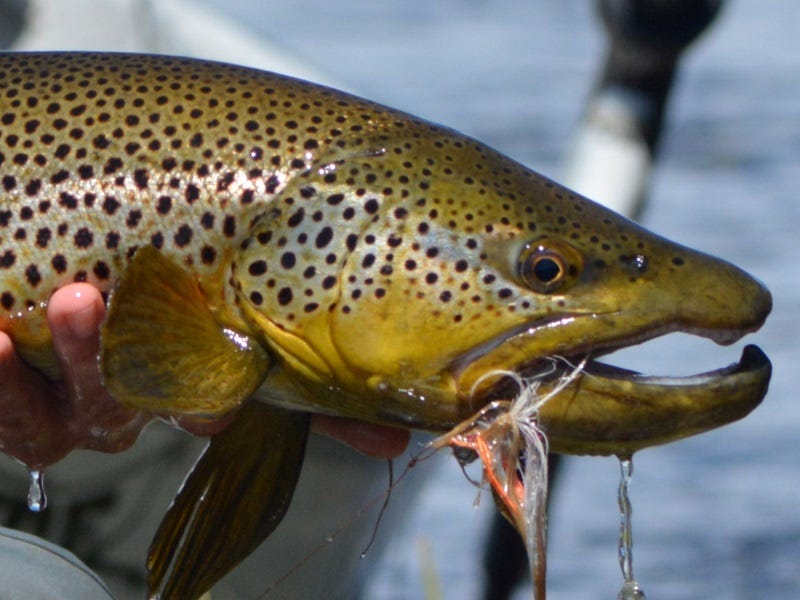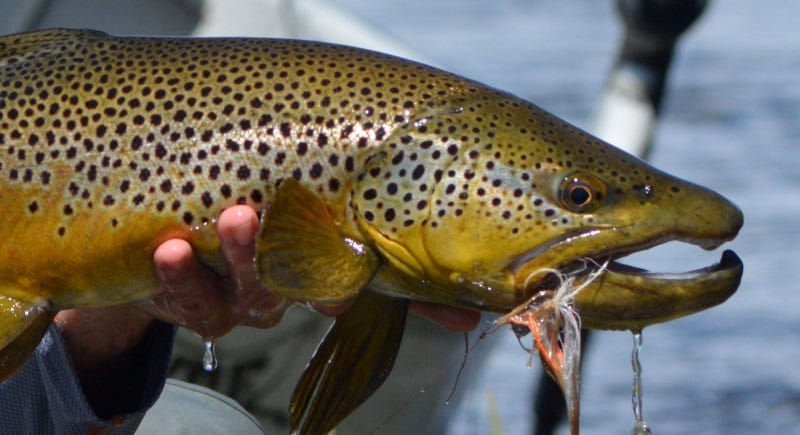Fishing Big Streamers for Large Trout

By Fred Telleen

Fishing big flies for trout is popular for good reason. That’s because there are an abundance of large streamer patterns being tied by creative anglers these days, and there is a new understanding that trout are, indeed, predators, and the largest ones mostly eat fish.
While fly fishing may have started with the goal of presenting diminutive little mayfly dries to surface feeding trout, the sport has broadened to include representations of anything a fish might eat, sculpins, mice, voles and birds included.
To increase your odds of catching a trophy sized trout, fishing big streamer flies is a step in the right direction. It is said that a trout will eat prey up to 1/3 their own length. That means a 16-inch trout will easily track down a 5-inch fly. A 24-inch trout will look at a 6-8-inch streamer as a quality food source. If you want a shot at a 30-inch fish, a 10-inch fly is not out of the question.
The first issue many anglers face when considering big flies, is how to cast them. Your standard 5-weight rod, matched with a 5 weight floating line and a 9-foot tapered leader won’t provide the energy needed to launch an articulated, dumbbell-eyed 6-inch mass of fur, feathers, hair, rubber and flash. To cast such a chunk, your fly line needs an adjusted mass, meaning it needs to be heavier. It also helps to use a rod with a little more spine, such as a 6-to 8-weight. A shorter leader helps, too.
Sinking Lines
When fishing big streamer flies, you’ll notice that they have a lot of resistance as they move through the water. To get the fly to sink more than a few inches on a retrieve, you’ll need to use a sinking line. These lines are easy to cast and they allow anglers to fish flies from a few inches to several feet beneath the surface. One of our favorite lines for properly handling big flies is the Airflo Streamer Max Short.
If you look at the Streamer Max Short line profile, you’ll see that the taper is followed by a girthy belly and the entire mass is compacted into a 26-foot length. A typical floating line taper runs closer to 40 feet. The benefit of the compressed taper, is that it puts more mass close to the fly. This puts physics in your favor if that fly is a big one. The aforementioned profile shows a the dimensions for a 5 weight, but we still recommend 6- to 8-weight rod for throwing large flies. To finish your setup, all you need is a 3-to 5-foot length of heavy tippet. Twelve to 20-pound material is the norm.
Airflo will soon offer a new line called the Streamer Max Shovelhead. We are looking forward to getting our hands on one and bringing it out on some of Montana’s big trout waters, including the Missouri River, which flows past our shop and kicks out some five-to 10-pound browns each year.
Floating Lines
Let’s say you are not concerned about depth and prefer fishing a floating line. The physics are still the same. You’ll want a shorter, compressed head to throw big flies. A great example is the Rio Pike/Muskie Line.
While the line was designed for Pike/Muskie, an 8-weight option is available and works equally well for tossing bulky flies to brown trout or casting poppers or subsurface flies for bass. Rio also offers a floating line called the Big Nasty, which is is available in line weights 6 and above.
Leaders and Tippet
When tossing a large fly with a floating line, it’s important to use a relatively short leader with a heavy butt section. Rio offers a Big Nasty tapered leader option or you can construct your own. My personal formula for a big-fly leader is constructed using approximately 40 inches of 40-pound test, 30 inches of 30-pound test, and 20 inches of 20-pound test. If your situation demands a lighter set up, you can reduce it to 30-pound, 20-pound, and 12-pound. I like to finish my leaders between seven and eight feet long if the water is clear and will shorten it down if the water is stained.
Flies
The choices are plentiful. Some flies are designed to closely represent food and others are more about attraction and reaction. Kelly Galloup has been a proponent of the big fly for many years and has developed many great patterns. Recently, many youthful fly tiers have embraced the articulated streamer, because they are fun to tie and the variations are endless. Of course, with the right set up, they are also fun and productive to fish.
Fishing with big flies is not for everyone, but if you want to participate, it all starts with the right fly line and tippet/leader system. Right now, we are right in the thick of big fly season because our brown trout are gearing up for the spawn and they are aggressive. If you need more assistance, stop into your North 40 Fly Shop and we will gladly set you up to cast big flies, for big trout, effectively.
Wonder what the river's doing? Check out our latest fishing reports here.
